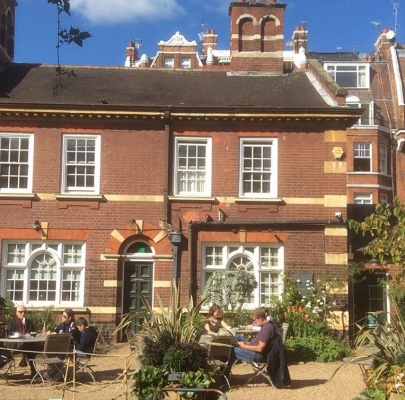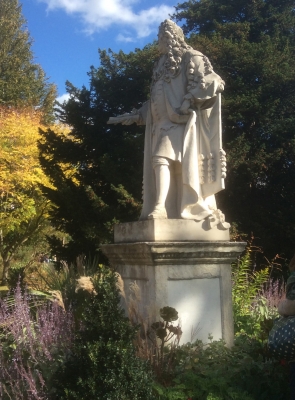Chelsea Physic Garden - Sowing Seeds of Discovery
Are there really 613 seeds in a pomegranate? Or is it just a tradition relayed around the fruit-laden festive table at Rosh Hashanah and, since this number coincides with the number of Torah commandments, maybe viewed as a positive omen with regard to family fruitfulness and multiplication?
On a visit to Britain last year I took a fascinating and hugely informative guided tour around the Chelsea Physic Garden in London, something that had been on my "to do" list for many a year. Standing meters away from a home-grown British pomegranate tree, I was asked by the very professional and charismatic in-house Physic Garden guide if it was true that this is the number of seeds supposedly to be found in the almost bomb-shaped, thick-skinned fruit with a yellowish lining and crammed with edible bright red seeds when ripe.
Addressing a small group of visitors from Australia, America, France and yours truly the British-Israeli, when approaching a rather anaemic-looking solitary pomegranate tree growing close to a high brick wall, the guide explained to the group that in the past people from Israel had told her about the fruit's 613 seeds and Torah connection.
As my Magen David necklace was visible, I wasn't surprised at her looking directly at me with a questioning look on her face when she related this piece of numerical information, then coyly and in a rather quiet voice, asked me directly if that was actually true.
To the best of my knowledge I told her that this is not so, as I vividly remembered many moons ago when my children were small, we attempted to count the seeds – and although we did not finish the job on hand, I certainly didn't recall they could possibly have been anywhere close to that particular number. But then again, the memory box isn't exactly what it used to be and I cannot imagine anyone having sufficient patience to try counting or, if off mark by a few, getting stuck into a recount!
Unlike the super-healthy fruit weighing down the scores of pomegranate trees found all over my kibbutz when in season, and in a cultivated local multi-fruit orchard known as the bustan, the skinny, droopy and tired looking British cousin apparently can only manage a rather limited number of fruits annually – and adds the guide rather sadly – the meagre offerings are small in size and it would be rather hard to believe they could hold their own on the tree should there be a whopping 613 seeds lodged inside.
To add further Israeli insult to British injury, the pomegranate fruit of the Chelsea Physic Garden are not edible and as far as the lady was aware, nobody had attempted – up until then that is – to count the seeds in the homegrown but inedible variety.
The location and unique microclimate of the high-walled Chelsea Physic Garden, situated a very short distance from the River Thames, has allowed highly revered English gardeners over the ages to grow plants, bushes and trees that are normally not found outdoors, since they are unable to face and survive Britain's harsh natural elements.
Among the reams of interesting historical facts and figures about how and what has been nurtured within the exotic garden walls, and records held thereby, is a fruit-giving olive tree. This is apparently the largest in the U.K., from which in the mid-1970s the head gardener harvested over three kilos of ripe olives, creating yet another pride and glory fact of Mother Nature to be notched up in the Chelsea Physic Garden historical records book.
A feeling of having entered a rather awesome secret garden descends almost immediately upon entering the Chelsea Physic Garden. Strolling around the neatly laid out plant beds, strips of neatly mowed lawn between each, the well-worn stone and gravel pathways, secluded and shaded corners created by massive, wide spreading, shade-creating trees, is as eye-popping as certain aromas are nose-tickling. A few wrought iron gateways and decorative railings lead across the road to the banks of the River Thames and a statue or two keep a watchful eye that guests adhere to the requests not to this or that, particularly not to touch nor pluck off any leaves in the section containing poisonous varieties of all sorts … although one would have thought the skull and crossbones signs should be sufficient to do the job.
Our super knowledgeable guide told of various known, and also not so well-known, folks in British history who had ended their days in agony having been administered one, or a concoction of, some of the pretty-looking but totally lethal herbs swaying to and fro in a gentle breeze, almost daring the visitor to pluck and try.
One of the Australians quips to his wife: "Might come back later and collect a few samples to try on your mother when we get home."
"Would need twice as much of everything to finish off your mother," she retorted with a hearty laugh.
In yet another fascinating section of the gardens, I have to admit that I did struggle a wee bit not to relieve them of a supply of tea leaves from the umpteen varieties in the cup of glory section, and then again when we hit the brimming-over herbal section, with absolutely tremendous aromas filling the air.
The Chelsea Physic Garden was established by the Worshipful Society of Apothecaries in 1673 in order to grow medicinal plants on the procured 4-acre plot, the site having been carefully chosen in order to gain from the proximity to the River Thames and to utilize the location's warm air currents. There was also an all-important jetty allowing the mooring of the Apothecaries' frequently-used barge as they went up and down river on plant-finding expeditions.
As was pointed out by the guide, on such forages into the plant world of known and unknown species, apprentices were taught to identify plants that might cure ailments – but also to identify those that might kill. Without doubt, it would seem they could have conjured up one or two powerful witches' brews with little effort, but also instigated medicinal plant solutions to human health problems, many of which are still used today.
The river access also allowed for plants arriving from around the globe to be introduced to the British Isles through the diligent work of the Physics Garden naturalists, scientists and students, with an international reputation established quickly as a result of the global seed exchange system, known as Index Seminum, initiated by the Apothecaries and still continuing in present times.
How many seeds, really?
For a definitive answer regarding the number of seeds in a pomegranate, we turn to Rabbi and Professor Dr. Ari Zivotofsky of the Brain Science Program at Bar Ilan University.
Based on exhaustive study, Prof. Zivotofsky concludes that pomegranates do not generally have 613 seeds, although it's possible an individual pomegranate does.
The professor describes a scriptural, rabbinic and cultural history of the pomegranate that dates, so to speak, to the Seven Species and the first fruits brought to the Israelites by the Twelve Spies (Numbers 13:23). His complete and fascinating study can be found at https://jewishaction.com/religion/jewish-law/whats_the_truth_about_pomegranate_seeds/
For further empirical study, Prof. Zivotofsky cites a continuing project that counts seeds from worldwide samples of pomegranates. The average number of seeds in the first 206 pomegranates counted turned out to be exactly 613! However, this number changes over time. The study can be found at www.aquaphoenix.com/misc/pomegranate/
Submitted by Maia Aron









Comments 1
Fascinating article indeed. I’ll try to make time to visit the physic garden when next in London…. Thank you Lydia👍🏻😊